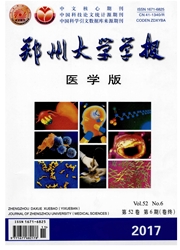

 中文摘要:
中文摘要:
目的:探讨外周血RASSF1A和FHIT基因启动子区甲基化与肺癌发生发展的关系。方法:应用实时荧光定量甲基化特异PCR(qMSP)方法检测200例肺癌患者和200例健康对照人群外周血RASSF1A和FHIT基因启动子区的甲基化率,分析其在2组人群中甲基化水平的差异,并分析年龄、性别、吸烟史、组织学类型及临床分期对基因启动子区甲基化率的影响。结果:2组外周血RASSF1A和FHIT基因启动子区甲基化率的差异有统计学意义(RASSF1A:Z=2.075,P=0.038;FHIT:Z=3.044,P=0.002)。肺癌患者的性别、年龄和吸烟史、组织学类型及临床分期与RASSF1A和FHIT基因启动子区甲基化无关。随着RASSF1A和FHIT基因启动子区甲基化水平增加,患肺癌的危险性增加[RASSF1A:β=0.235,OR(95%CI)=1.551(1.023~2.353);FHIT:β=0.091,OR(95%CI)=1.763(1.116~2.671)]。结论:RASSF1A和FHIT基因启动子区的甲基化与肺癌有关,检测外周血中RASSF1A和FHIT基因启动子区甲基化水平可能有助于肺癌的早期预警。
 英文摘要:
英文摘要:
Aim : To investigate the relationship between promoter methylation status of cancer suppressor genes fragile histidine triad (FHIT)and ras association domain family 1A (RASSF1A) in peripheral blood and the development of lung cancer. Methods:The blood samples of 200 lung cancer patients and 200 normal controls were collected to determine the methylation levels of RASSF1A and FHIT using real-time PCR. Results: For both genes, there were significant differences in the methylation levels between lung cancer patients and controls ( RASSFI A : Z = 2. 075, P = O. 038 ; FHIT: Z = 3. 044, P = 0. 002). There were no associations between gender, age, smoking history, histological type, or clinical stage with RASSF1A and FHIT gene promoter methylatiou in the lung cancer group. The risk of lung cancer increased with the in-creased of methylation levels of RASSF1A and FHIT genes [ RASSF1A:β = 0. 235, OR (95% CI) = 1. 551 ( 1. 023 - 2.353 ) ; FHIT :/3 = O. 091, OR( 95% C/) = I. 763 ( 1. 116 - 2.671 ) ]. Conclusion: The aberrant promoter methylation of RASSFIA and FHIT is related to lung cancer. To detect RASSF1A and FHIT gene aberrant promoter methylation levels may contribute to early warning o{ lung cancer and the prediction of lung cancer risk.
 同期刊论文项目
同期刊论文项目
 同项目期刊论文
同项目期刊论文
 期刊信息
期刊信息
